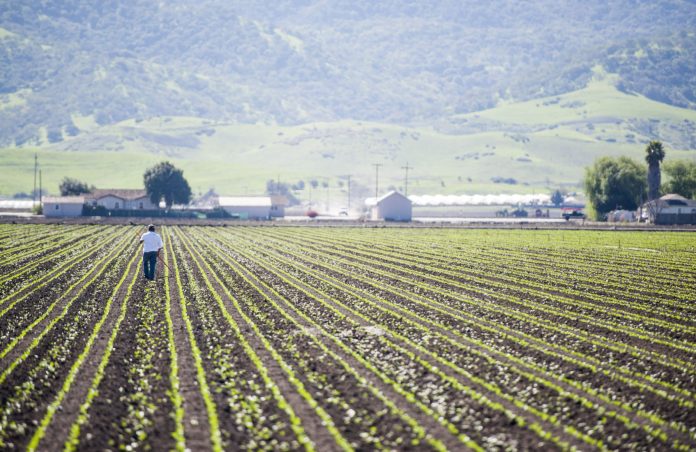Shaded by his wide sombrero, the man in the field pulled a hoe through a row of bright green lettuce sprouts in San Juan Bautista.
In the same 20-acre plot off Highway 156, a large machine hummed through rows of crops, doing the same work. Called a Mantis auto-thinner, the one man operated machine does the work of 10 to 15 people by using cameras and computers to locate and chemically burn extra plants. As farmworker wages increase, using this kind of new technology will become more cost effective, said Tony Alameda, manager of Topflavor Farms.
“As of right now, it’s probably an even push,” he said.
Across the state, farmers are seeing a shortage of labor and are exploring how to fill the void. Some farmers, including Alameda, are looking to mechanize the lowest-paying jobs, which are hardest to keep filled. Others are creating company-owned housing to make it easier for workers to move to the area to harvest seasonal crops. Some farmers are even paying a premium to bring in workers from outside the country.
“The wages are going up because we’re all competing for fewer workers,” Alameda said to the Free Lance. “People are making more money because of supply and demand.”
The reasons for the shortage are complicated. Farmers say immigration is not happening like it was; a higher state minimum wage took effect in January; and there has been a local increase in berry harvesting and construction jobs, which soak up local labor sources by offering higher wages.
Domestic—or locally sourced—workers, such as the man in the sombrero, might make $10 to $11 an hour weeding or removing extra sprouts from the row crops, Alameda explained. Harvest wages are higher and can be $15-20, he said.
As berries start in mid-March, the labor pool dries up since harvest wages are higher, Alameda said. But the real labor crunch comes in mid-August, which is the harvest season for grapes, tomatoes, berries and all vegetables, he said.
It is a shortage that has intensified in recent years.
“We’ve been filling the shortage probably for three or four years,” said Scott Rossi, the farm manager for Tanimura & Antle.
Rossi lives in Hollister but farms in Salinas. Last year, he lost workers to other industries including truck driving, the growing berry business and construction jobs, he said.
“Farm workers in general are kind of just moving around,” Rossi said, “seeing other industries.”
Affordable housing is also an issue for many workers, who might otherwise come to the area to harvest seasonal crops. To solve this issue, the company is building housing for about 800 people, the first phase of which will be done in April, Rossi said.
“One of the big things is housing,” he said. “People are not willing to travel to other areas because there is a lack of housing in Salinas Valley and Hollister.”
The H-2A program, which allows foreign workers to move temporarily to the U.S. to perform seasonal agricultural work, is another option that some farmers use to fill the void.
But it is costly and requires additional planning. For the H-2A program, farmers must pay a government set prevailing wage—which was $11.89 in 2016—and pay for food, housing and transportation, making the effective rate probably $18-20 an hour, Alameda said.
Mark Wright, the farm manager for Hollister-based Filice Farms, cited immigration issues, competition with the construction industry, and the high cost of living in the area as reasons for a shortage of farm workers.
“All labor is hard but definitely being out in the fields and stuff, it’s not easy stuff,” he said.
The farm strives to pay above minimum wage in order to get as much available workforce as possible, he said.
“There’s a range of wages out there but minimum wage obviously set the price and then it’s up to each individual operator to decide where they can afford to be in wages,” Wright said. “Everybody operates individually. So they have their prices that they’re able to pay. But workforce and availability, it all comes into play.”
Filice Farms—which produces tomatoes, onions, peppers, Romaine lettuce, celery, cherries and spinach—is trying to mechanize certain tasks but it is difficult to use machines for the hand-harvest jobs, he said. Bell peppers, cherries and raspberries must be hand picked, the farm manager explained.
“Every single strawberry a person eats was all picked by hand one at a time,” he said. “We can’t do this stuff without labor. We recognize that.”
Back in the lettuce fields off Highway 156, the machine hummed through the crops, selecting which plants would grow into full-sized heads of lettuce. The plastic and metal giant had cameras, computers and a single employee inside. The cost of running it, including the price of chemicals, is probably $100 an acre, said Frank Heffren, a pest control advisor with Mantis.
“As labor has gotten short, you see these kind of things,” Alameda said. “And I don’t see it getting any better.”










